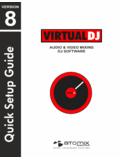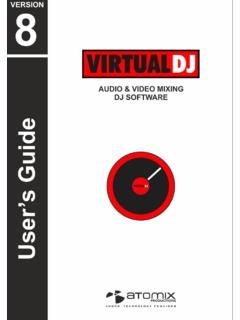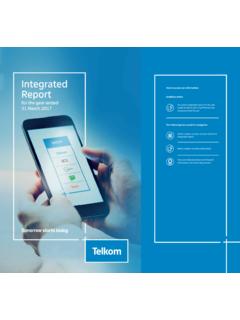Transcription of MCX8000 User Guide - denondj.com
1 User Guide 2 Table of Contents 4 Box Contents .. 4 Support .. 4 5 Features .. 6 Top Panel .. 6 Front Panel .. 12 Rear Panel .. 12 Using Serato DJ .. 14 Mixing with Serato DJ .. 14 Selecting Decks in Serato DJ .. 14 Navigating & Loading Tracks .. 14 Playing Tracks .. 15 Performance View .. 15 Pitch Functions .. 18 Beatgrid Functions .. 19 Loop Functions .. 20 Pad Modes .. 21 Cue Mode .. 21 Cue Loop Mode .. 22 Flip Mode .. 23 Roll Mode .. 24 Saved Loop Mode .. 25 Slicer Mode .. 26 Slicer Loop Mode .. 27 Sampler Mode .. 28 Velocity Sampler Mode .. 29 Pitch Play Mode .. 30 Playback/Performance Functions .. 31 Effects .. 32 3 Using Engine .. 33 Getting Started .. 33 Mixing with Engine .. 33 Navigating & Loading Tracks .. 33 Categories .. 35 Crates .. 36 Playlists.
2 37 Playing Tracks .. 38 Performance View .. 39 Pitch Functions .. 41 Loop Functions .. 42 Pad Modes .. 43 Cue Mode .. 43 Roll Mode .. 43 Slicer Mode .. 44 Effects .. 44 Using the Utility Menu .. 45 Technical Specifications .. 49 Trademarks & Licenses .. 50 4 Introduction Box Contents MCX8000 USB Cable Power Adapter Software Download Card Quickstart Guide Safety & Warranty Manual Support For the latest information about this product (system requirements, compatibility information, etc.) and product registration, visit 5 Setup Important: Occasionally, we may update MCX8000 s firmware to improve its performance. Visit to check for available firmware updates, especially after you update your software (firmware updates may address new software features).
3 Note: Items not listed under the Introduction > Box Contents are sold separately. 1. Visit and log into your account. (Create an account if this is your first Denon DJ product.) 2. In your account, download and install the latest versions of Engine and Serato DJ. 3. Windows users only: In your account, download and install the latest Windows driver. 4. Connect input sources (microphones, CD players, etc.) to MCX8000 . 5. Connect output devices (headphones, power amplifiers, loudspeakers, etc.) to MCX8000 . 6. Plug all devices into power sources, and turn on devices in proper order: When starting a session, turn on (1) input sources, (2) MCX8000 , (3) output devices. When ending a session, turn off (1) output devices, (2) MCX8000 , (3) input sources. 7. To use Serato DJ: Using a Hi-Speed USB cable (included), connect the USB port on MCX8000 to your computer.
4 Open Serato DJ and go! For more information on how to use Serato DJ with MCX8000 , visit and select Denon DJ MCX8000 . To use Engine (standalone playback): Insert a USB flash drive (with an Engine-configured music library) to one of MCX8000 s USB ports. Computer Monitors Powered Loudspeakers Microphone Headphones (to front panel) Power AudioPlayer(smartphone, tablet, etc.)Hard Drive(This hub will connect to your computer; you cannot access its content using MCX8000 .) Turntable,CD Player, etc. USB Flash Drive (on top panel) 6 Features Top Panel 2144456872144456897214445687214443333568 71314151610 10 10 1016171818192021272829303132333435363837 39 40 414243 4445 4548464750515254555756585960 60 606161 6162636464656553493526222425231717171512 11 1. Input Selector: Set this switch to the desired audio source from this channel: PC (a track playing on that layer in Serato DJ), Line (a device connected to the Line Input on the rear panel), or Engine () (a track on a connected USB flash drive; Decks 1 and 2 only).
5 Please note that the Line/Phono selector switches on the rear panel must also be set properly. Also, a channel s controls will only send MIDI information when its Input Selector is set to PC. 2. Channel Level: Turn this knob to adjust the level of the pre-fader, pre-EQ audio signal for the channel. 3. Channel Level Meters: These LEDs display the audio signal level of the channel. 4. Channel EQ: Turn these knobs to boost or cut the high, mid-range, and low frequencies for the channel. 5. Channel Filter: Turn this knob to adjust the filter applied to the channel. Turn the knob counterclockwise to apply a low-pass filter. Turn the knob clockwise to apply a high-pass filter. 6. Channel Cue: Press this button to send the channel s pre-fader signal to the headphones cue channel.
6 7. Channel Fader: Use this fader to adjust the channel s volume level. Press and hold Shift and move the fader to activate Fader Start in Serato DJ or Engine. 7 8. Crossfader Assign: Routes the audio playing on the corresponding channel to either side of the crossfader (L or R), or bypasses the crossfader and sends the audio directly to the program mix (center, Thru). 9. Crossfader: Use this crossfader to mix between the two active decks. 10. Channel FX: Use these buttons to apply Effect A and/or B to the corresponding channel while using Serato DJ. While using Engine or when the Input Selector is set to Line, Decks 1 and 3 can use FX 1 only, and Decks 2 and 4 can use FX 2 only. 11. Sampler Volume: Turn this knob to adjust the volume level of the sampler in Serato DJ.
7 12. Master Level Meters: These LEDs display the audio signal level of the master mix (sent out of the Master Outputs). These levels are post-Master Level, so they are an accurate measurement of the audio signal sent out of the Master Outputs. 13. Master Level: Turn this knob to adjust the volume level of the Master Outputs. 14. Booth Level: Turn this knob to adjust the volume level of the Booth Outputs. 15. Booth EQ: Turn these knobs to boost or cut the high and low frequencies for the Booth Outputs. 16. Mic Level: Turn these knobs to adjust the volume levels of the corresponding microphone inputs. The Peak light next to each knob indicates the current signal level by its color: green (low), amber (normal/optimal), or red (maximum/peak). Important: The audio signals from the microphones are routed directly to the Master Outputs.
8 17. Mic EQ: Turn these knobs to boost or cut the high and low frequencies for the corresponding microphones. 18. Echo On/Off: Press this button to activate or deactivate the echo effect on the microphones audio signal. 19. Mic Echo Level: Turn this knob to adjust the amount of the echo effect on the microphones audio signal. 20. Mic On/Off: Press this button to activate or deactivate the microphones. 21. Talkover/Post: Press this button to use the talkover feature, which automatically reduces the volume level of the master mix when you speak into the microphone. Press and hold Shift and then press this button to activate or deactivate the post feature. When on, the microphones signal will not be sent to the Booth Outputs.
9 22. Phones Level: Adjusts the volume of the headphones. 23. Phones Mix: Adjusts the software s audio output to the headphones, mixing between the cue output and the master mix output. 24. Split Cue: When this switch is in the On position, the headphone audio will be split such that all channels sent to cue channel are summed to mono and sent to the left headphone channel and the master mix is summed to mono and sent to the right channel. When the switch is in the Off position, the cue channel and master mix will be blended together. 25. X-F Link: Press this button to link or unlink the Serato Video crossfader to the audio crossfader. 26. Deck: Selects which virtual deck is controlled by that hardware deck. The left deck can control Deck 1 or 3; the right deck can control Deck 2 or 4.
10 27. Shift: Press and hold this button to access secondary functions of other controls. 8 28. Sync / Sync Off: While using Serato DJ, press this button to automatically match the corresponding deck s tempo with the tempo and phase of the opposite deck. While using Engine, press this button to automatically match the corresponding deck s tempo with the tempo of the opposite deck. The Sync button on the master deck will flash. Press and hold Shift and press this button to deactivate Sync. Important: Sync is not possible between Serato DJ and Engine. Trying to sync a deck playing a track in Serato DJ to a deck playing a track in Engine can produce unexpected results. 29. Cue / Track Start: During playback, press this button to return the track to a temporary cue point.





